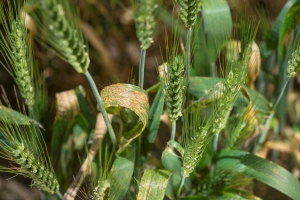Updated risk management advice for Septoria
Updated risk management advice for Septoria
Date: 29 Sep 2020

Growers in the high rainfall zones of southern Australia have a new resource to help guide their management when it comes to the serious wheat disease Septoria tritici blotch (STB).
The Grains Research and Development Corporation’s STB fact sheet provides growers with up-to-date information on the disease as well as guidance on fungicide use to avoid promoting fungicide resistance.
STB is the most significant disease of wheat in the high rainfall zone (HRZ) and has also made its way into parts of the medium rainfall zone (MRZ).
Agriculture Victoria Senior Plant Pathologist Grant Hollaway says opportunities to control STB in the MRZ have all but passed as harvest approaches.
“Growers who have identified STB in this year’s crop should be planning their disease management strategy for next season, starting with paddock selection,” he says.
“Avoiding wheat on wheat rotations and early planting of susceptible varieties will reduce the infection risk.
“STB is a stubble-borne disease so anything which accelerates stubble decomposition over summer is also beneficial.”
The new fact sheet details the agronomic and fungicide usage practices required to manage STB without promoting fungicide resistance.
Growers in the HRZ who may still need fungicide to control outbreaks in their crop are reminded to rotate fungicide mode of action (MoA) groups to avoid over-exposing the pathogen to any one chemistry.
Foundation For Arable Research Australia (FAR Australia) Managing Director, Nick Poole, who also contributed to the new fact sheet, says fungicide resistance in STB is a significant threat.
“Repeated use of the same fungicide MoA promotes resistance and we only have Group 3, Group 7 and Group 11 fungicides available for controlling STB,” he says
“Losing one of those through over-use will limit our ability to rotate the remaining MoAs, causing a domino effect.”
Both Mr Poole and Dr Hollaway are contributors to the GRDC-supported Australian Fungicide Resistance Extension Network (AFREN), which is focused on improving grower knowledge and management of fungicide resistance issues.
Dr Hollaway also discusses the latest insights on STB in a GRDC podcast.
-
GRDC PodcastPodcast
GRDC Podcast: Septoria Tritici Blotch emerges once again
Septoria Tritici Blotch has re-emerged as a disease that growers in the southern region should watch out for.
Date: 03 Jun 2020
Contact details
For interviews
Tess Vallance, Agriculture Victoria
0456 605664
tess.vallance@ecodev.vic.gov.au
Nick Poole, FAR Australia
03 5265 1290
nick.poole@faraustralia.com.au
Contact
GRDC Adelaide office Communications Manager – South
(08) 8198 8400
media@grdc.com.au
GRDC Project Code: DAN00177, BLG207, DAN00203, DAV00136, DAV00129, DJP1907-001RTX, DJP1905_002SAX, FAR 00004-A,


